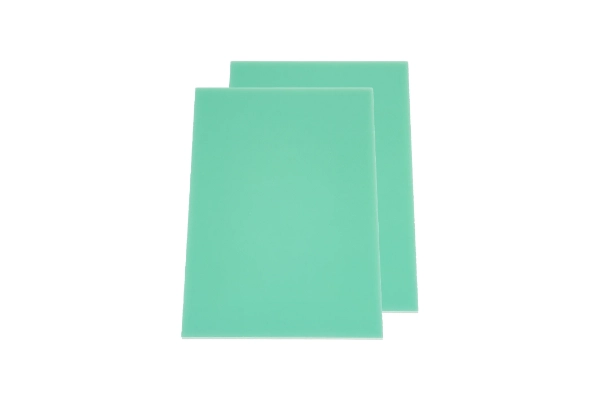- This topic is empty.
-
AuthorPosts
-
08/05/2025 at 17:58 #86139
G10 epoxy resin laminate is a high performance thermosetting composite material that has become a cornerstone in the electronics, industrial sectors. Known for its excellent mechanical strength, chemical resistance, and dielectric properties, G10 is a type of glass-reinforced epoxy laminate widely used for printed circuit boards (PCBs), insulating washers, and structural components. In this blog post, as a high performance G10 fiberglass sheet manufacturer, Blue Sun will share the G10 epoxy resin laminate manufacturing process, including raw material selection, etc.
Manufacturing Process of G10 Epoxy Resin Laminate
1. Raw Materials Selection
The manufacturing process of G10 begins with the selection of high-quality raw materials, which consist of:
– Reinforcing Material: Woven fiberglass cloth, typically made from E-glass (electrical-grade glass), serves as the base reinforcement. The fiberglass provides structural strength and dimensional stability.
– Matrix Resin: Epoxy resin, usually based on bisphenol-A or bisphenol-F with an anhydride or amine curing agent, acts as the matrix material. Epoxy is chosen for its strong adhesion, low shrinkage, and excellent dielectric properties.
The quality and consistency of these raw materials are critical to the performance of the final laminate. The glass cloth must have a uniform weave, and the epoxy resin must exhibit controlled viscosity, gel time, and reactivity.
2. Resin Impregnation (Prepregging)
The next step involves impregnating the fiberglass cloth with a partially cured epoxy resin to create a material known as "prepreg." This process occurs in an impregnator or resin bath system and includes:
– Resin Preparation: The epoxy resin and hardener are blended with additives such as accelerators, stabilizers, and wetting agents. These additives tailor the viscosity, cure rate, and final properties.
– Impregnation: The fiberglass cloth is continuously unwound and passed through the resin bath, where it is thoroughly wetted by the resin. Tension is controlled to avoid distortion of the weave.
– B-Stage Curing: After impregnation, the resin-coated fiberglass passes through a heated drying oven (typically 120–180°C). The heat partially cures the resin into what is called the B-stage—where the resin is tack-free and solid but still capable of fusing under heat and pressure.
– Cutting and Stacking: Once cooled, the prepreg is cut into sheets or rolls of defined dimensions and stacked for further processing.
3. Layup and Stacking
The prepreg sheets are stacked to the required thickness of the final G10 laminate. The orientation of each layer is carefully aligned to maintain uniform mechanical properties. In most applications, layers are stacked in the same direction, although cross-ply configurations can be used for enhanced dimensional stability.
4. Laminating Press Process
The stacked prepreg sheets are then subjected to a high-temperature, high-pressure curing cycle in a platen press. The main parameters during lamination include:
– Temperature: Typically between 170–190°C (338–374°F), depending on the resin formulation.
– Pressure: Ranges from 3.5 to 6.9 MPa (500 to 1000 psi), ensuring that voids are eliminated and resin fully wets the fiberglass.
– Time: The curing cycle lasts 1 to 2 hours, though this may vary depending on the laminate thickness and specific resin system.
During this stage, the epoxy undergoes a complete thermosetting reaction, transitioning to a highly crosslinked network that is chemically stable and mechanically robust. The process is monitored using thermocouples and pressure sensors to ensure consistent quality.

5. Cooling and Demolding
After curing, the press is cooled under pressure to below 50°C to avoid residual thermal stresses. Once cooled, the laminate is removed from the press and inspected for defects such as:
– Surface imperfections (e.g., voids, resin-rich areas)
– Delamination
– Warpage or misalignment
Edge trimming is also performed to bring the panels to standard sizes, typically 36" x 48" or as per customer specifications.
6. Post-Curing (Optional)
For some high-performance applications, post-curing may be employed. This involves placing the laminate in an oven at a lower temperature (100–150°C) for several hours. Post-curing enhances the glass transition temperature (Tg) and dimensional stability, especially important in thermal cycling environments.
7. Quality Control and Testing
Rigorous quality control is essential in G10 production. Typical tests performed on G10 laminates include:
Mechanical Testing:
– Tensile strength (ASTM D638)
– Flexural strength (ASTM D790)
– Compressive strength (ASTM D695)
Electrical Testing:
– Dielectric breakdown voltage (ASTM D149)
– Volume and surface resistivity (ASTM D257)
– Arc resistance (ASTM D495)
Thermal Testing:
– Glass transition temperature (Tg) via DSC or DMA
– Coefficient of thermal expansion (CTE)
Dimensional and Visual Inspection:
– Thickness tolerance (±0.005 in typical)
– Flatness and squareness
– Surface finish (smooth, matte, or glossy depending on pressing method)
Only laminates that pass all specifications are released for sale or further processing.
8. Secondary Processing
Depending on end-use, the G10 laminates may undergo additional operations such as:
– CNC machining to create structural components or insulators
– Drilling and punching for fastener holes or electrical clearance
– Silkscreening or laser marking for identification and traceability
In PCB manufacturing, the G10 core is drilled, plated, etched, and layered with copper to create multilayer circuit boards.
9. Packaging and Storage
To maintain quality during storage and shipping:
– Laminates are cleaned to remove dust or residues
– They are sealed in moisture-resistant packaging to avoid hydrolysis or moisture uptake
– Stored flat in controlled environments (<60% RH, 20–25°C)
Shelf life is generally indefinite under proper conditions due to the thermoset nature of cured epoxy.
Conclusion
The manufacturing process of G10 epoxy resin laminate involves a highly controlled sequence of material preparation, resin impregnation, thermal curing, and post-processing operations. The success of each stage directly impacts the final material’s electrical insulation capability, mechanical strength, and dimensional integrity. Due to its superior performance characteristics, G10 continues to be a material of choice in applications ranging from consumer electronics to defense-grade hardware.
http://www.bluesun-elec.com.cn
Blue Sun -
AuthorPosts
- You must be logged in to reply to this topic.